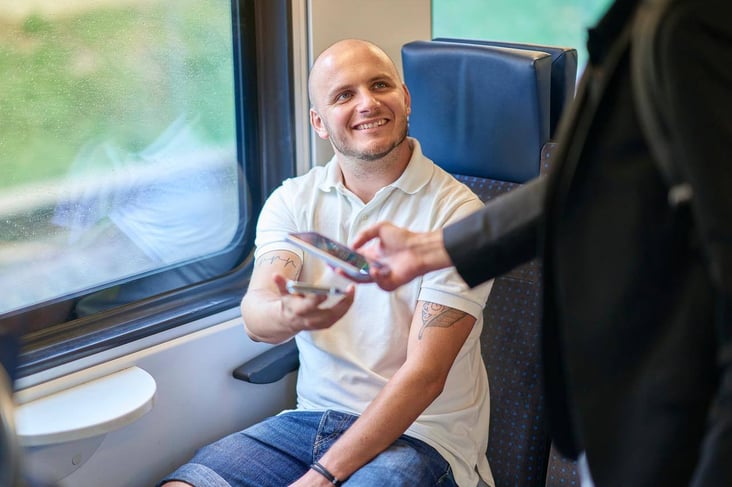
Public transport and user centricity
The user friendliness of public transport was the focus of this year's FAIRTIQ Forum. The diverse event programme, which featured speakers from the worlds of academia and design as well as the transport sector itself, explored the subject from many different angles. Our goal was to generate maximum added value for you and your operations. What became clear from the wide-ranging presentations is just how multidimensional user friendliness actually is. How easy is it for me to buy a ticket? Are stations clean and welcoming? Is public transport really accessible to all, especially passengers with limited mobility? Is taking public transport an enjoyable experience? Ultimately, it is about passengers forming an emotional and positive bond with the bus and train services they use rather than viewing them as a mere means to an end.
More than 100 people registered for this year's FAIRTIQ Forum; among the attendees were representatives of transport companies and associations not only from Switzerland but from Germany, Austria and Luxembourg, too.
2021 FAIRTIQ Forum – Presentations
Mobility design – Rethinking eco-mobility, with Prof. Kai Vöckler from Hessen State University of Art and Design
What contribution can design make to mobility products, processes and facilities? How can the function and design of public transport create a positive mobility experience and encourage more people to make the shift to sustainable mobility?
These were some of the questions which Prof. Kai Vöckler from Hessen State University of Art and Design addressed during his guided tour through the world of mobility design. Prof. Vöckler explained how public transport and other eco-friendly products can be made more appealing to users and what the sector could learn from the car industry and its approach to design. He stressed the need to view mobility also as a non-tangible experience; it therefore would make total sense for the industry to appeal to and engage with users at an emotional level, too. For Prof. Vöckler, the digital design of public transport offerings and digital ticketing solutions should be more in sync with the customers' analogue public transport experience. At the end of the panel discussion which followed his presentation, Prof. Vöckler posited that within 10 years mobile ticketing apps will already be a thing of the past.
eFare launch in North Rhine-Westphalia, with Anja Höhn, Sales Manager at Kölner Verkehrsbetrieben (KVB)
Two public transport providers in North Rhine-Westphalia – the Verkehrsverbund Rhein-Sieg (VRS) and Kölner Verkehrsbetrieben (KVB) – have been trialling the FAIRTIQ app, with great success, across their services since April 2019. As of 6 December, users of the VRS eezy.nrw app as well as the FAIRTIQ app have been able to benefit from the new state-wide eFare when travelling in the region.
Ms Höhn spoke of the initial concerns she and her team had before the pilot project began. They worried, for example, whether the technology would actually work and whether customers would accept the solution, especially owing to fears they might have as regards the use of their data. Not only have as many as 12,000 test users taken part in the VRS eFare pilot but their extensive feedback has been overwhelmingly positive too, with many appreciating the user-friendliness of the app and the simplicity of the new distance-based fare; user confidence in the new eFare also grew quickly. The success of the pilot was one of the reasons why KVB decided to pursue its successful partnership with FAIRTIQ and roll out the eFare across North Rhine-Westphalia.
Nightjets: how ÖBB responds to customer needs, with Kurt Bauer, Head of Long-Distance Transport at ÖBB
Nightjet is the name given to the passenger overnight train service operated by Austrian Federal Railways (ÖBB). The network stretches from Northern Germany to central Italy, and serves several European cities and destinations. With Nightjet, the ÖBB is at the vanguard of the passenger night train revival and is already planning to expand the service in the coming years. According to Kurt Bauer, Head of Long-Distance Transport at the ÖBB, digital sales channels are key to leveraging Nightjet's full potential. Given that yield management is an especially complex challenge when it comes to night train services, Bauer explained that it is imperative that operators bring in professionals to help them design an optimal fare model.
When developing the Nightjet service, ÖBB listened to the criticisms and desires of its customers, and from the outset made every effort to respond to them. On the outside, ÖBB's night trains look exactly like standard trains. Inside, it is a different story; the interiors of the Nightjets have been designed to make them as user-friendly and comfortable as possible.
Product management workshop, with Luise Rohland, digital marketing specialist at FAIRTIQ
All products and services have a user interface (UI) and a user experience (UX). What do public transport services' UI and UX look like and how are they perceived by the customers? To what extent are these customers involved in efforts to improve service quality? These were some of the issues that were addressed during the product management workshop with Luise Rohland.
Luise is a digital marketing specialist at FAIRTIQ. It is her job to analyse data and use the resulting insights to attract more users to FAIRTIQ and make the app more user-friendly.
During the workshop, Luise explained why quantitative data is an invaluable source of information when developing products. She stressed, however, that when it comes to understanding users and their needs, quantitative data is no substitute for direct interaction with the customer. She also presented different types of anonymised data sources, such as customer service data and surveys, which FAIRTIQ shares with its partners. For a deeper dive into smart data use, take a look at this blogpost.
What the user wants. Inspiring ideas for user-centric mobility, with Lieke Ypma, partner @ Hello Impact
Customers love user-centric solutions. When we are travelling, we encounter solutions that work and others that are often a source of frustration. What is user-centric mobility? What is it that users most want? How can products be developed in a user-centric way?
Lieke Ypma is a co-founder of Hello Impact Berlin, which specialises in developing strategies and innovations for the mobility and digital sectors. Ms. Ypma also teaches on the Smart City Design Master's programme at Macromedia University As well as training the digital urban planners of the future, she is an active contributor to the field of mobility education and writes on the subject of female mobility.
Ms. Ypma showed that customer insights can help solve concrete problems, which in turn facilitates the development of a marketable product. These insights are usually derived from qualitative data analyses conducted as part of exploratory studies.
Quantitative data are also a vital source of information, particularly for ongoing product improvement. One of the central principles here is ease of use.
According to Ms Ypma, if a product is to succeed, it must meet users' needs. As a result, the product development process requires a great deal of time and thought. Transparency is also important here, especially as regards data protection. She added that control should be given back to the customer. The product developer can achieve this by providing reliable information and communicating in a clear and appropriate way.
'It’s an EasyRide with SBB Mobile', with Fabian Kern from SBB
Since 2019, FAIRTIQ technology has powered the backend of the SBB ticketing app 'EasyRide'. Fabian Kern from Swiss Federal Railways pointed out that EasyRide is not the only app in Switzerland to use FAIRTIQ technology (SDK).
EasyRide is the most popular mobile ticketing app in Switzerland; around 200,000 tickets are purchased via the app every day. The home screen features a series of modules and manually configurable tiles featuring all the important information and access that a traveller might need. Mr Kern explained that user experience is also extremely important for SBB; once customer needs are identified, they are directly integrated in the UX design. The next step is to check the technical feasibility of these changes and the resources required to implement them. Based on this information, SBB weighs the benefits for the customer against the costs. At the moment, SBB is testing a new travel credit feature that lets test users travel for CHF 1,000 but pay only CHF 800. SBB worked with FAIRTIQ to develop and implement the feature.
Workshop with Cornelia Wenger and Barbara Tobler from the FAIRTIQ Marketing Team
At FAIRTIQ, marketing is data-driven and tailored specifically to the target audience. It too follows the FAIRTIQ growth hacking cycle: ideas are tested quickly and then measures go through several optimisation rounds or are replaced with new ones.
FAIRTIQ works closely with its public transport partners. We can provide them with marketing materials like vehicle wraps and posters for their buses and trains. We also offer them the possibility of joint, multichannel online advertising campaigns. These can even be tailored to a given region in order to reach potential new customers precisely where they use public transport. To drive sustainable growth, we also deploy various customer acquisition measures like the FAIRTIQ Member-get-Member programme. In terms of user reactivation, we can send out personalised mailshots featuring incentives like a free journey or the planting of a tree the next time the customer uses the app; the latter has proved to be particularly effective.

Future Outlook, with Gian-Mattia Schucan, FAIRTIQ founder and CEO
He announced that FAIRTIQ users will soon be able to purchase multiple tickets in the app, e.g. for other passengers, their dog or their bike. Although this is something that users have long wanted, the complexity of this feature meant that building it took a great deal of time and effort.
FAIRTIQ also wants to boost corporate customer growth. A while back, it introduced a feature that lets users set up two payment profiles (one for business travel, the other for personal travel). Additional incentives like this one are already in the works.
In these uncertain times, it is more important than ever that FAIRTIQ is able to support the public transport sector with any fare-related and marketing issues they might have, and help them implement the necessary solutions. Although we already offer the 'Performance Dashboard' which provides insights into user behaviour in a given region, more data should be made available to operators to help them plan more effectively.
The concept of 'Seamless travel' will inform much of FAIRTIQ's future activities. We are committed to making it easier to move between different fare zones and regions.
Thank you to our guest speakers and panellists for their valuable contributions to the event!
We have been bowled over by the enthusiasm and interest that you all have brought to FAIRTIQ Forum 2021.
The event has given the FAIRTIQ team a host of new ideas and inspiration on how we too can improve our user friendliness.
We look forward to seeing you all – in person, hopefully – at next year's FAIRTIQ Forum!




.jpg?width=732&name=220907hallandstrafiken-buss7103%20(2).jpg)


Share